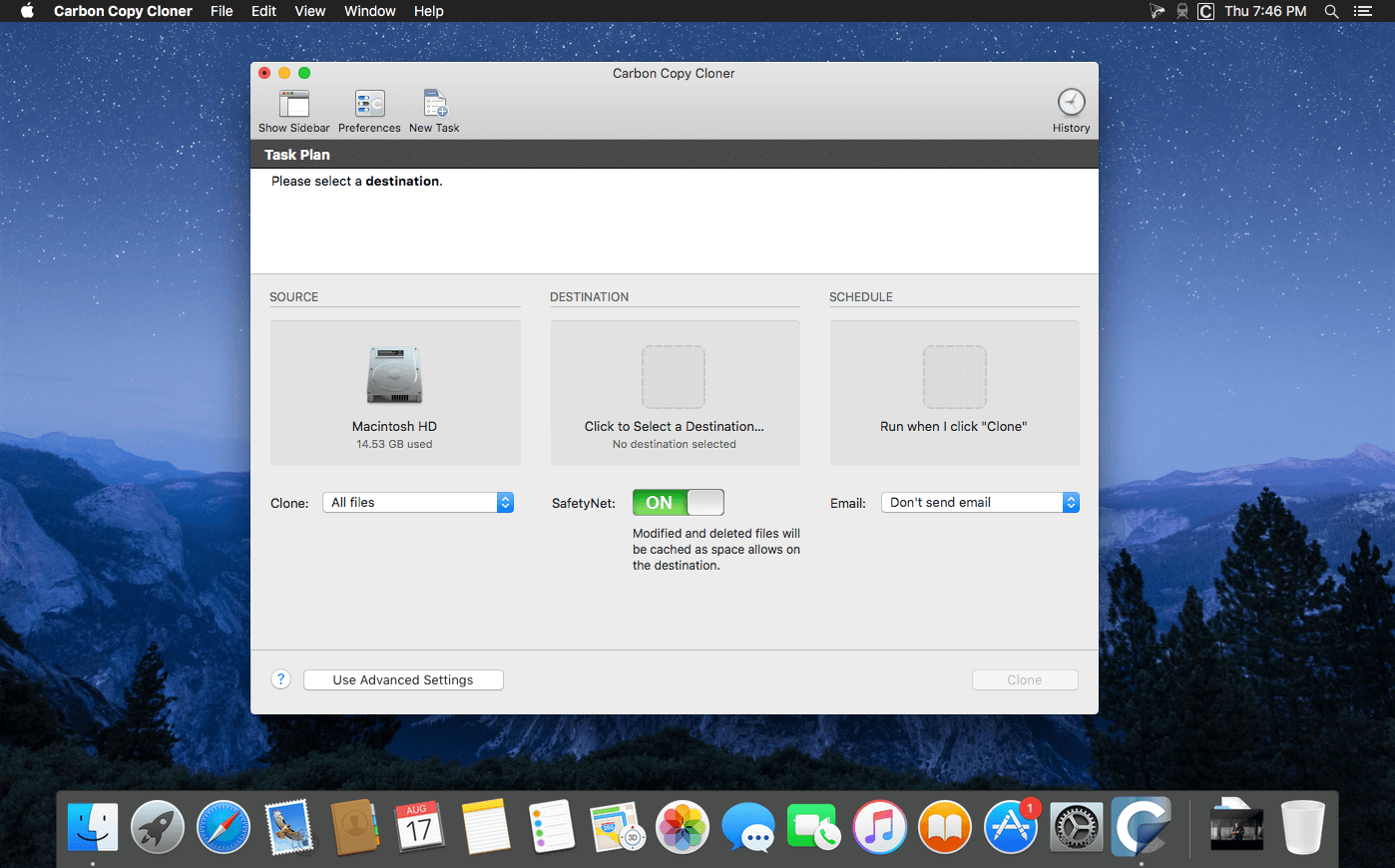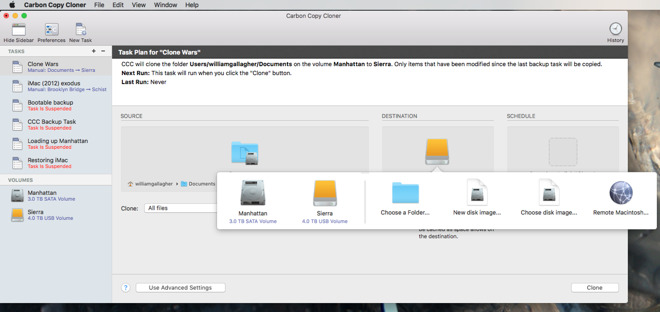Download Carbon Copy Cloner 5.1.25.6155 for Mac for free, without any viruses, from Uptodown. Try the latest version of Carbon Copy Cloner 2021 for Mac. For Mac OS X 10.4 and later, including Leopard. Users of Mac OS X Panther (10.3) and Mac OS X Jaguar (10.2) should download Carbon Copy Cloner.

In this video, I'm going to show you guys how to clone a file, a folder, or an entire drive using a application called Carbon Copy Cloner. It is a very strai. Carbon Copy Cloner is a bootable backup solution for the Mac. Suppose the unthinkable happens while you're under deadline to finish a project - your Mac is unresponsive and all you hear is an.
First we would like to thank all our loyal users, especially the ones who have donated!
Since we have been subject to abuse of our API from several large companies and smart phone app creators who have incorrectly implemented our API, we have essentially been DDoSed for the past few months. (and our SSL cert expiring *doh*)
We have tested the new site a few times during off-peak hours and the results are extremely promising! If you would like to help test our beta site, please Contact Us and let us know you are interested in the beta. We will get back to you with a link when the beta is live.
Our current site will continue to operate without the API enabled and once the beta site goes live, all (correct) API queries will be backward compatible with the new website.
Please feel free to contact us via our Contact Us page with any questions, improvements, requests, ideas, or anything at all you may have.
Especially if you have any improvements or feature requests for the new site, we will accomidate and pack as many features as we can into the new site before it goes live!

Thank you!
Some Big Sur startup volumes don't appear in the Startup Disk Preference Pane
In the past, the Startup Disk Preference Pane would list all available startup volumes, including volumes cloned by CCC (whether CCC used ASR or its own file copier). Some Big Sur cloned volumes do not appear in the Startup Disk Preference Pane, despite being perfectly bootable.
We have reported this issue to Apple (FB8889774) and we are currently awaiting a response.

Workaround: To boot from the cloned volume, restart your Mac while holding down the Option key, then select the cloned volume in the Startup Manager. When your Mac has completed booting, you can optionally choose to set the startup disk to the current startup volume (i.e. if you want the Mac to always boot from the cloned volume).
CCC will not update the System volume on a Big Sur bootable backup
Starting in macOS Big Sur, the system now resides on a cryptographically sealed 'Signed System Volume'. That volume can only be copied using Apple's proprietary APFS replication utility ('ASR'). Right now, ASR will only copy whole volume groups (System and Data), we can't choose to clone just the System volume. As a result, every time an OS update is applied to the source, we would have to erase the whole destination volume (including any existing snapshots on that volume) just to update the system on the destination.
To avoid deleting your snapshots and the rest of your backup, CCC will not update the System volume on the destination when System updates are applied to the source.
We made a feature request to Apple in September 2019 (FB7328230) to allow ASR to clone just the System volume. Apple's APFS team acknowledged the request in June 2020 and clarified the requirements, and now we're waiting on the implementation.
Our recommendation: We recommend erasing the destination only for the purpose of establishing the initial bootable backup. CCC can then use its own file copier to maintain the backup of your user data, applications, and system settings. If you would like to update the OS on the backup volume, you can boot your Mac from the backup and apply any updates via the Software Update preference pane in the System Preferences application. This is not something that we anticipate you would need to do frequently, nor even proactively. You could apply updates before attempting to restore from the backup, for example, if that need ever arises.
Apple Software Restore doesn't yet support the storage in Apple Silicon Macs
In the current shipping version of macOS Big Sur (11.2.3), Apple's ASR utility cannot replicate the startup disk in an M1-based Mac. Attempting to do so results in an error:
'Apple System Restore Tool': Source volume format not yet supported in this version of macOS
Apple is aware of the problem and is working towards resolving it for a future update to macOS. CCC 5.1.23+ will automatically perform Data Volume backups on M1 Macs and avoid any attempts to copy a System volume on those Macs — that's a complete backup of your data, applications, and system settings. If you would like to make your Apple Silicon Mac backup bootable, you can install Big Sur onto the CCC Data Volume backup. Please keep in mind, however, that your CCC backup does not have to be bootable for you to be able to restore data from it.
When Apple posts an update to macOS that resolves the ASR problem, we'll post an update to CCC that adds back support for copying the System volume on these Macs.
Finder will not show, nor allow you to set custom icons on other Catalina and Big Sur startup disks
Finder will show and allow you to customize the volume icon for your current startup disk, but not for other Catalina- or Big Sur-bearing startup disks that your Mac is not currently booted from. This problem is not specific to CCC backups, but we see this frequently because CCC creates bootable backups. This problem is the result of a design flaw in the implementation of custom icons in an APFS volume group. Up to macOS Catalina, the custom volume icon is stored in a file at the root of the startup disk named '.VolumeIcon.icns'. To keep the System volume read-only, yet allow the apparent modification of this icon file, Apple chose to create a symbolic link at the root of the startup disk that points to System/Volumes/Data/.VolumeIcon.icns. For the current startup disk, this path resolves correctly because the Data member of the volume group is mounted at /System/Volumes/Data. That's not the case for external volumes, those Data volumes are mounted at /Volumes/CCC Backup - Data (for example). As a result, the symbolic link to .VolumeIcon.icns is unresolvable for any volume that is not the current startup disk.
Ccc Mac Big Sur
We have reported this issue to Apple (FB7697349) and we are currently awaiting a response.
Other Catalina and Big Sur startup disks can't be renamed in the Finder
Finder will let you rename the current startup disk, but you won't be able to rename any other startup disks that have an installation of Catalina or Big Sur because the System volume is mounted read-only.
Solution: Unmount and remount the volume in Disk Utility, then right-click on the volume in Disk Utility's sidebar and choose the option to rename the volume.
Ccc Mac Online
We have reported this issue to Apple (FB8912480) and we are currently awaiting a response.
The System volume is not encrypted when FileVault is enabled on a Big Sur startup disk
This is not a bug, this appears to be a deliberate change on macOS Big Sur. When you enable FileVault on a Big Sur startup disk, the System volume member of the APFS volume group is not encrypted. Considering that this volume is identical on all Macs, encrypting its contents is not going to prevent someone from knowing what's on it, so the encryption does appear to be unnecessary. There is one undesirable effect of this change, however, regarding an encrypted, bootable backup disk. When you attach the device to your Mac, the System volume is mounted automatically, regardless of whether you unlock the associated Data volume. If you specifically choose to not unlock the Data volume, there are three results that range from confusing to annoying to alarming:
- The volume appears to be mounted in the Finder, despite not wanting to mount it
- None of the data on the volume is accessible because the Data volume isn't mounted, so you might be led to believe that your data has been lost
- There is no apparent way in the Finder to get the Data volume unlocked and mounted
You can unlock and mount the Data volume in Disk Utility to access the data. If you provided the volume's password to CCC, then you can simply run your CCC backup task and CCC will automatically unlock and mount the Data volume.
We have reported this issue to Apple (FB8918177) and we are currently awaiting a response.
Apple's SMB filesystem client causes system stalls on M1 Macs, leads to kernel panics

We have received several reports from M1 Mac users of kernel panics that occur while copying files to an SMB-mounted NAS volume. The kernel panic reports have confirmed that the SMB filesystem client (implemented via the smbfs.kext kernel extension) was stalled, which led to a 'watchdog' panic. These panic reports are automatically submitted to Apple, so we can presume that Apple is aware of the problem and working on a solution.
Ccc Mac Mail
Workaround: Users have reported that using AFP rather than SMB consistently works around the panic (in cases where using AFP is an option):
Ccc Macau
- Eject the NAS volume if it's currently mounted
- Choose 'Connect to Server' from the Finder's Go menu
- Type in 'afp://{server address}' to connect to the NAS volume via AFP
- Open CCC and select the applicable backup task
- Drag the currently-mounted NAS volume (or folder or disk image on that volume) onto CCC's source or destination selector (whichever is applicable for your particular task)
